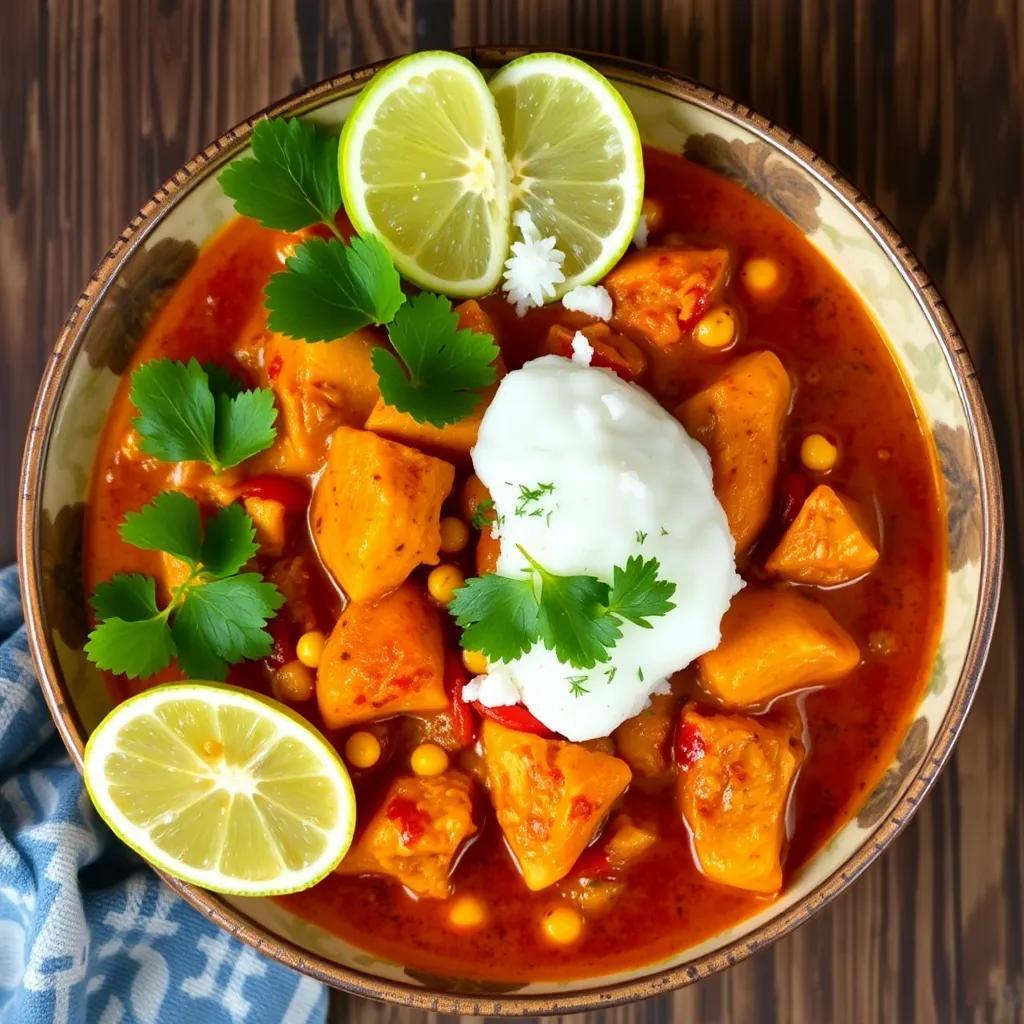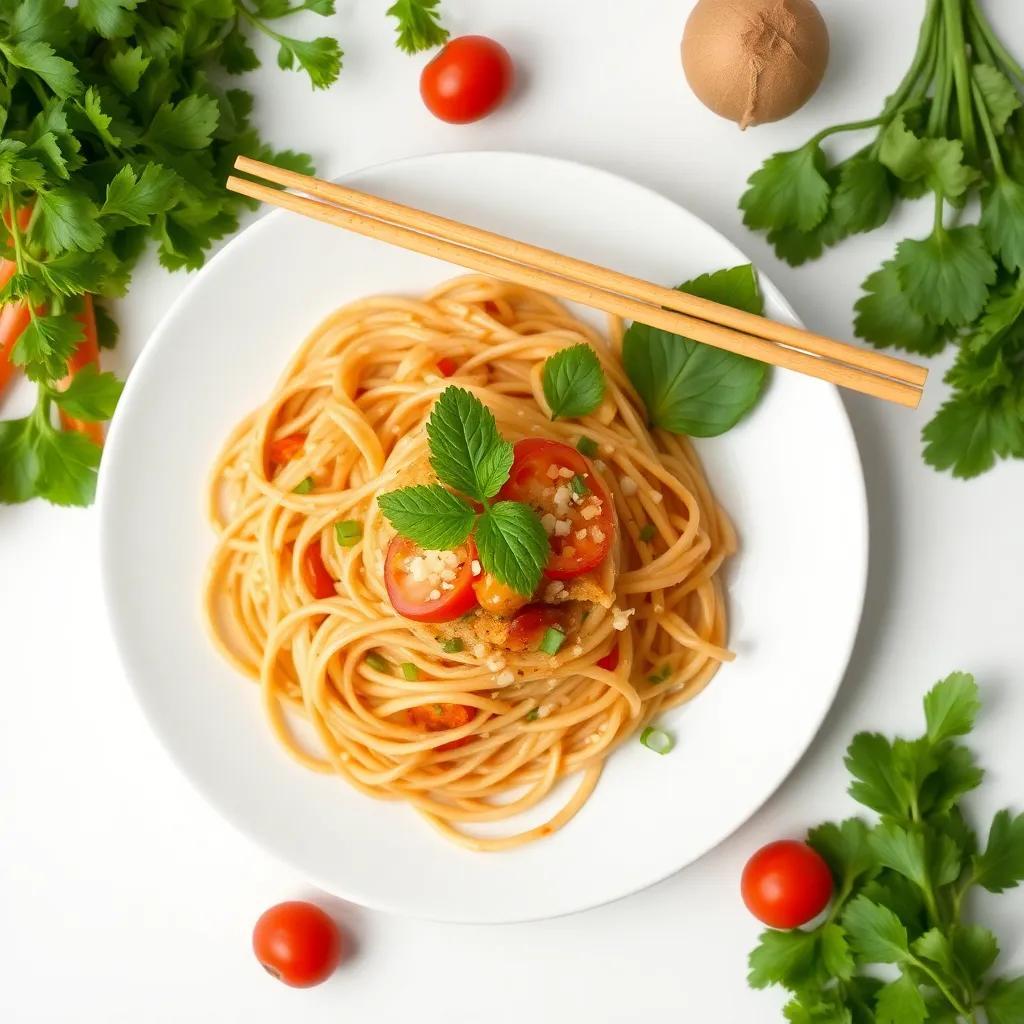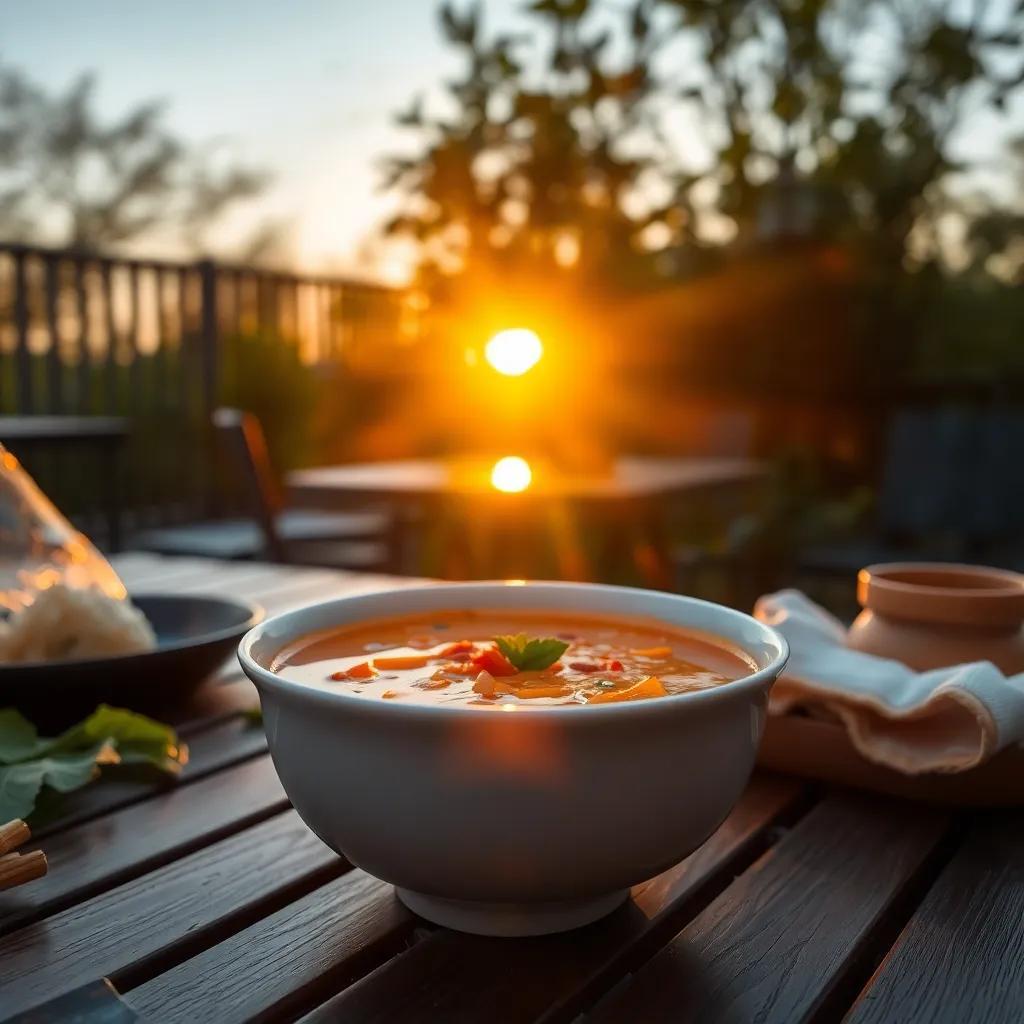Irresistible Thai Basil Chicken Recipe: Easy, Flavor-Packed & Ready in 30 Minutes
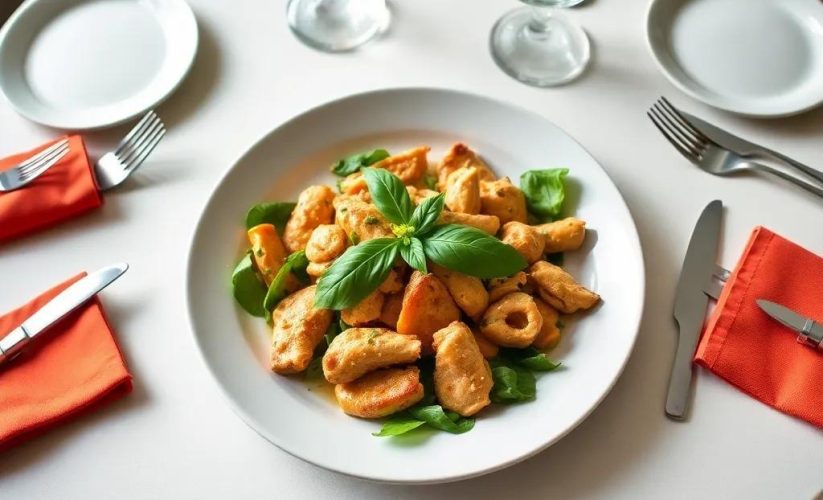
Irresistible Thai Basil Chicken Recipe: Easy, Flavor-Packed & Ready in 30 Minutes
🌍 Cuisine: Thai
⚙️ Difficulty: Easy
Ingredients
Nutrition Facts
350
Instructions
- Prepare all the ingredients: mince garlic, slice shallots, and chop Thai red chilies.
- Heat vegetable oil in a large skillet or wok over medium-high heat.
- Add minced garlic, sliced shallots, and chopped chilies to the hot oil. Stir-fry for about 1 minute until fragrant.
- Add the ground chicken to the pan. Break it apart with a spatula and cook until it turns white and is mostly cooked through, about 5–7 minutes.
- Mix in soy sauce, fish sauce, oyster sauce, and sugar. Stir well to combine the flavors evenly.
- Pour in water or chicken broth to loosen the mixture and prevent sticking. Stir fry for another 2 minutes.
- Turn off the heat, then immediately stir in the fresh Thai basil leaves until wilted and fragrant.
- Serve hot over steamed jasmine rice for a complete meal.
Serving Suggestions
- Serve with steamed jasmine rice to soak up the delicious sauce.
- Add a fried egg on top for an authentic Thai street food experience.
- Pair with a side of cucumber salad for a refreshing contrast.
- Garnish with extra fresh Thai basil or cilantro for added aroma.
- Serve alongside spring rolls or Thai-style appetizers for a complete meal.
- Adjust chili levels to suit your heat preference, or substitute with milder peppers.
- Use ground turkey or pork as an alternative to chicken for variation.
Table of Contents
- Intro
- Ingredient Notes
- Tips & Variations
- Leftovers & Storage
- Behind the Recipe
- FAQ
- Your Turn in the Kitchen
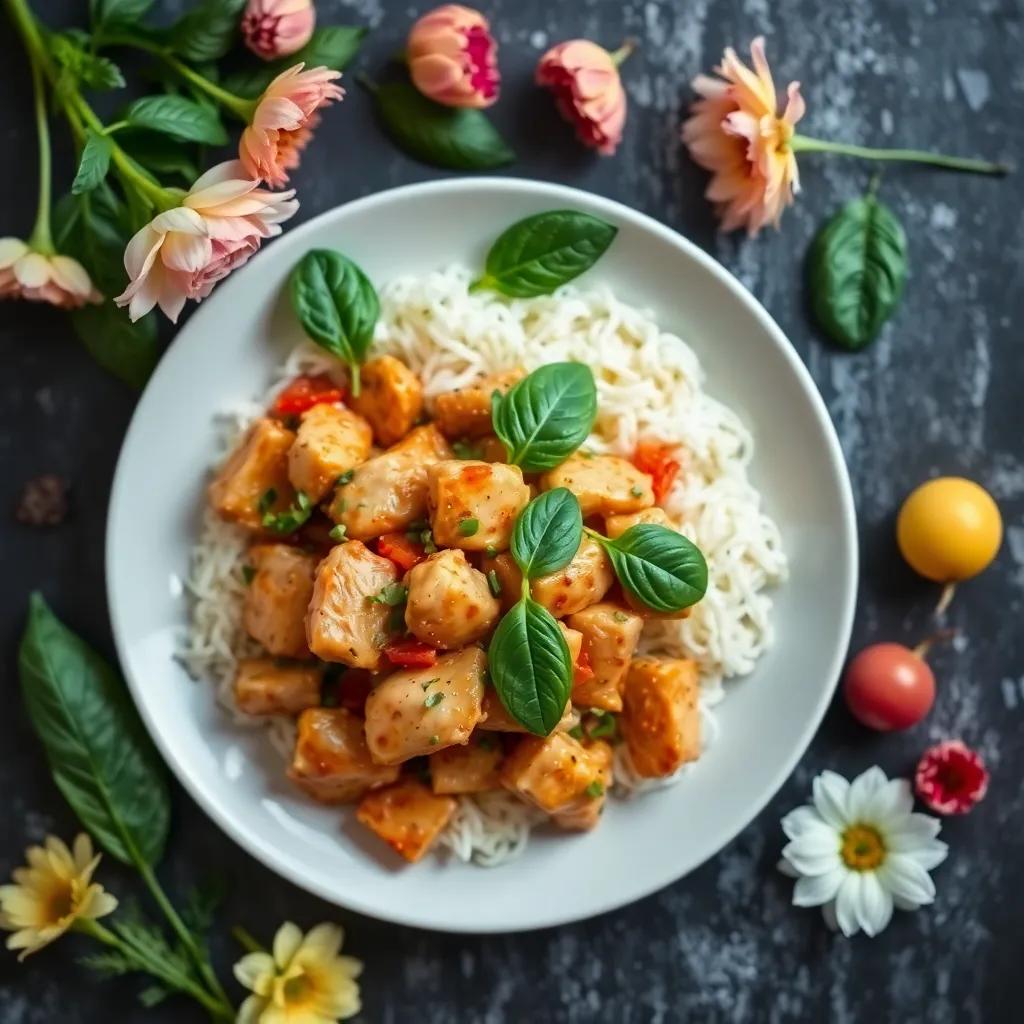
Intro
Experience the vibrant flavors of Thailand right in your own kitchen with this Thai Basil Chicken recipe that balances boldness and simplicity beautifully. It’s the kind of dish that feels both familiar and exciting—a perfect harmony of savory, spicy, and aromatic notes that come together effortlessly. Whether you’re craving a quick weekday dinner or want to impress guests with something exotic yet approachable, this recipe fits the bill.
What makes this dish truly special is how quickly it comes together without sacrificing depth of flavor. In just about 30 minutes, you can craft a satisfying meal that’s packed with complexity but doesn’t require a long list of complicated steps. It’s an ideal choice for those busy evenings when you want something fresh and homemade but don’t have hours to dedicate to the stove.
This recipe also shines in versatility—it’s perfect served on a casual family dinner table, great for meal prepping lunches during a hectic week, and even impressive enough for a flavorful dinner party centerpiece. No matter the occasion, Thai Basil Chicken delivers a comforting yet exotic experience that brings a little taste of Southeast Asia to your home cooking repertoire.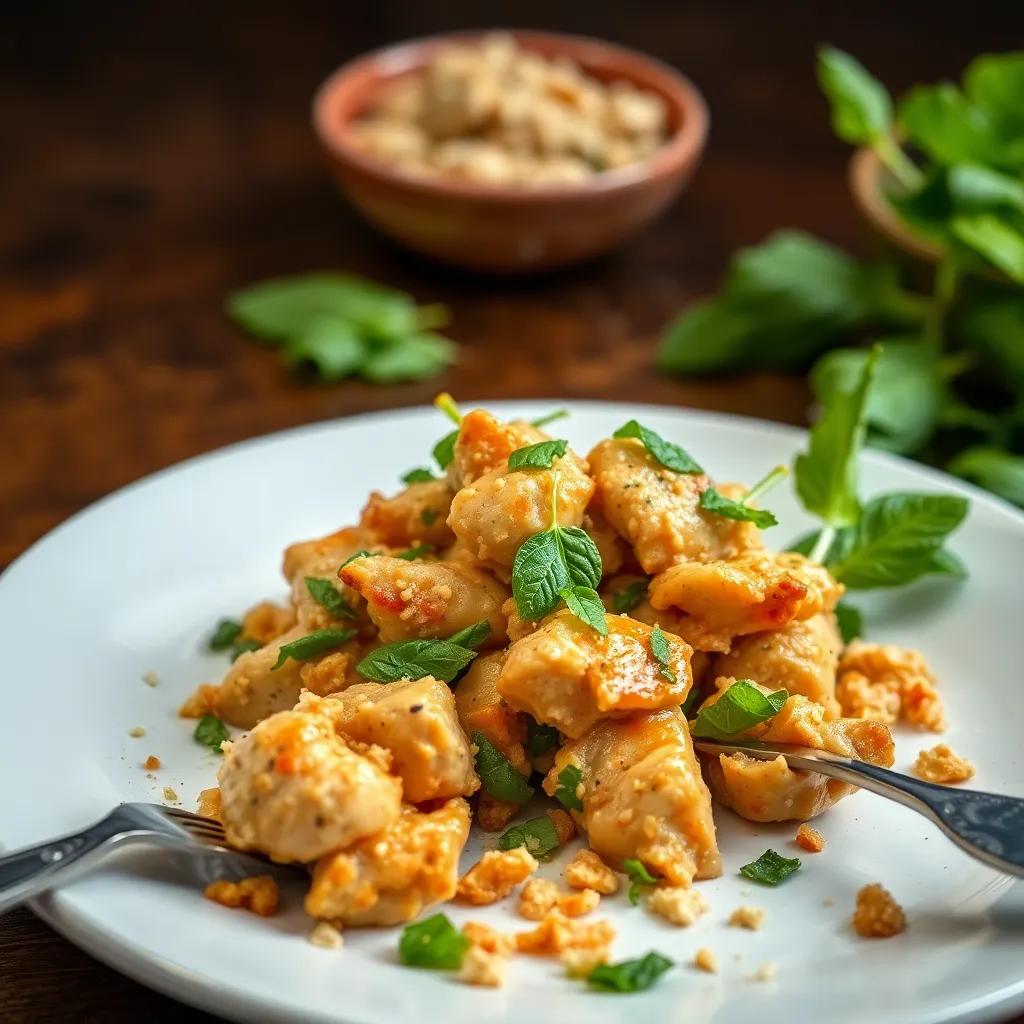
Ingredient Notes
In this Thai Basil Chicken recipe, a few key ingredients play starring roles, each bringing unique textures and tastes that elevate the dish beyond ordinary weeknight fare.
Thai Basil Leaves
Unlike the sweet basil commonly found in Western kitchens, Thai basil has a distinct, slightly spicy aroma with hints of anise and licorice. This herb is crucial to the dish’s authentic flavor profile, imparting a bright, fresh lift that balances the savory richness of the sauces. When shopping, look for vibrant green leaves without any yellowing or wilting. If fresh Thai basil is hard to find, you can substitute with sweet basil in a pinch—though the flavor will be milder and less complex. For a closer match, some specialty stores or Asian markets sell Thai basil seeds or even frozen leaves.
Fish Sauce
Fish sauce is a fermented condiment that provides a deep umami punch, essential in Thai cooking for layering savory complexity. It’s salty but also subtly pungent, so it works beautifully alongside soy and oyster sauces to create the perfect balance. When selecting fish sauce, opt for varieties with minimal additives—those made traditionally with just fish and salt tend to have a richer, cleaner taste. If you need a substitute, a mix of soy sauce with a small amount of anchovy paste can mimic some of its depth, but the final flavor won’t be quite the same.
Thai Red Chilies
These tiny, fiery chilies are responsible for the signature heat that wakes up the entire dish. Their bright spice is sharper and more immediate than many larger chili varieties, giving just the right kick without overwhelming the other flavors. Fresh is best, but dried or chili flakes can serve as alternatives if fresh Thai red chilies aren’t available. Remember to adjust the quantity based on your tolerance for spice—removing seeds can reduce heat without sacrificing flavor.
Oyster Sauce
Oyster sauce adds a glossy, slightly sweet and savory richness that rounds out the savory notes in the stir-fry. It’s thicker and less salty than soy sauce, helping build layers of flavor and a luscious texture. When buying oyster sauce, check for products made from real oysters rather than artificial flavorings for the best taste. If you need a substitute due to dietary restrictions or availability, mushroom-based vegetarian oyster sauce works well for replicating its umami essence.
By giving special attention to these ingredients, you ensure your Thai Basil Chicken captures the authentic spirit and irresistible layers of flavor that make this dish a beloved classic.
Tips & Variations
To take your Thai Basil Chicken to the next level, here are some pro tips and creative variations that let you customize this dish to suit your taste, pantry, and dietary needs.
- Master the stir-fry technique: Using a very hot wok or skillet is key for that restaurant-quality sear and quick cooking. This high heat locks in juices and creates slight caramelization without drying out the chicken. Make sure to stir constantly and break the meat into small crumbles to promote even cooking.
- Adjust the heat thoughtfully: If you’re sensitive to spice, start with just one Thai red chili or remove the seeds, which hold much of the heat. For those who crave fiery heat, add an extra chili or a pinch of crushed red pepper flakes at the end. Fresh chilies deliver brightness that dried flakes can’t quite replicate, so balance accordingly.
- Make it gluten-free: Swap traditional soy sauce with tamari or coconut aminos to keep that savory umami punch without gluten. Double-check your oyster sauce as many contain wheat; thankfully, gluten-free oyster sauces or mushroom-based options can stand in nicely.
- Go vegan or vegetarian: Replace ground chicken with textures like finely chopped king oyster mushrooms, crumbled tofu, or cooked lentils to mimic protein bite and mouthfeel. Use vegetarian oyster sauce and skip fish sauce—tamari or a splash of seaweed broth can help layer back that umami in its place. Don’t forget to increase the garlic and chili a bit to boost flavor depth.
- Experiment with proteins: While ground chicken is classic, ground turkey, pork, or even beef make excellent substitutes, each bringing a slightly different richness. For seafood lovers, try diced shrimp or fish filets added toward the end of cooking for a lighter twist.
- Boost fresh herbs and aromatics: Thai basil is essential, but if you want to play with complexity, add a handful of fresh cilantro or mint alongside it. A sprinkle of finely sliced green onions or a squeeze of fresh lime right before serving adds bright, zesty highlights.
- Customize the sauce balance: Taste and tweak your soy, fish, and oyster sauce levels to suit personal preferences. Some like it saltier, others sweeter—adding a splash of dark soy sauce can deepen color and flavor, while a pinch more sugar or a drizzle of honey lends subtle sweetness that balances the heat.
- Add texture and crunch: Toasted cashews or crushed peanuts sprinkled on top create delightful contrasts to the tender chicken and wilted leaves. You can also toss in thinly sliced bell peppers or snap peas during the last couple of minutes for added freshness and bite.
- Use broth creatively: Water is fine to loosen the stir-fry, but substituting with chicken or vegetable broth enriches the flavor base subtly. A splash of coconut milk could add a hint of creaminess for an indulgent touch.
By keeping these tips and variations in mind, you can turn this easy Thai Basil Chicken recipe into a versatile masterpiece that’s perfectly tailored to your family’s favorite flavors and any dietary preferences you might have.
Leftovers & Storage
After enjoying a flavorful feast of Thai Basil Chicken, you might find yourself with some delicious leftovers—luckily, this vibrant dish stores beautifully and makes for an excellent next-day meal or meal prep option. To keep your leftovers tasting fresh and mouthwatering, follow these simple storage guidelines.
First, allow the Thai Basil Chicken to cool to room temperature before packing it away. This prevents condensation from building up inside containers, which can lead to sogginess or faster spoilage. Use airtight containers—glass or BPA-free plastic works best—to lock in flavors and maintain moisture without making the chicken stew in excess liquid.
When stored properly in the refrigerator, leftovers will stay fresh for up to 3 to 4 days. This makes it perfect for easy lunches or quick dinners during a busy week. If you want to extend its shelf life further, you can freeze portions in freezer-safe containers or sturdy resealable bags. Be sure to divide the dish into meal-sized portions before freezing, so you can reheat just what you need without thawing the whole batch. Frozen Thai Basil Chicken will keep well for up to 2 months, retaining most of its bold flavors and texture.
Reheating is best done gently: warming leftovers in a skillet over medium heat with a splash of water or broth helps revive the saucy coating and keeps the chicken moist. Microwaving on medium power with a loosely covered lid also works—just stir halfway through heating to ensure even warmth. Adding a few fresh Thai basil leaves during reheating can refresh the aromatic notes and brighten the dish.
Finally, if you plan to pack this for lunches or road trips, be sure to keep the chicken chilled until mealtime to maintain food safety. Using insulated lunch boxes and small ice packs can help preserve freshness and flavor throughout the day.
With minimal effort, your Thai Basil Chicken leftovers transform effortlessly into a quick, tasty meal that feels just as satisfying as when freshly made—making this dish not only irresistibly delicious but wonderfully practical for everyday cooking.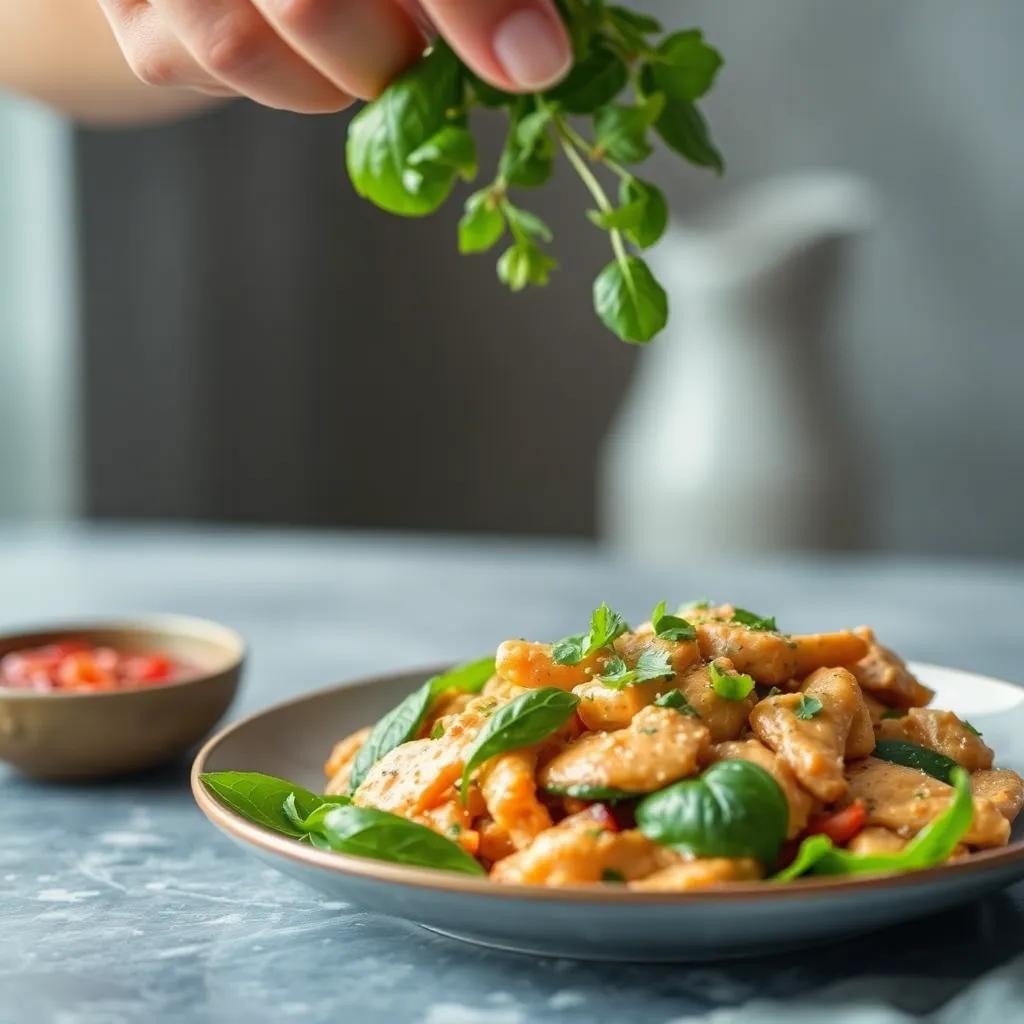
Behind the Recipe
Thai Basil Chicken, or Gai Pad Krapow as it’s known in Thailand, is much more than a quick weeknight dinner—it’s a beloved staple that reflects the heart of Thai street food culture. This dish originated as a humble, home-cooked meal, designed to be fast, satisfying, and bursting with vibrant flavors that awaken the senses without elaborate preparation.
The magic of Thai Basil Chicken lies in its balance: sweet, salty, spicy, and herbal notes dance together in perfect harmony, capturing the essence of Thai cuisine’s flavor philosophy. Traditionally cooked over a roaring hot wok, the dish showcases the skill of quick stir-frying, where freshness and timing are everything. The fresh Thai basil leaves, added right at the end, release their characteristic aroma, providing the signature fragrant finish that makes the dish instantly recognizable.
For many Thai families, Gai Pad Krapow serves as comfort food—a quick fix after a long day and a reminder of home-cooked warmth. If you’ve ever visited Thailand’s bustling night markets or street stalls, you’ll find this dish served sizzling hot on rice, often topped with a runny fried egg. It’s a snapshot of everyday life in Thailand, where food is communal, vibrant, and deeply satisfying.
In creating this recipe, the goal was to capture that authentic street food spirit in a straightforward format that anyone can master at home. Whether you’re new to Thai cooking or revisiting familiar flavors, this dish invites you to experience a little piece of Thailand’s culinary soul—one fragrant bite at a time.
FAQ
Can I use tofu instead of chicken for a vegetarian version?
What’s the best way to store leftovers?
Can I make this dish ahead of time and freeze it?
What can I use if I don’t have fresh Thai basil?
How spicy is this recipe, and can I adjust the heat?
Is there a gluten-free way to make this dish?
Your Turn in the Kitchen
There you have it—a vibrant, mouthwatering Thai Basil Chicken dish that’s as quick to make as it is bursting with bold flavors. Perfect for busy weeknights or anytime you crave a little taste of Thailand, this recipe brings together simplicity and spice in every bite.
Give it a try and see how easily it can become a new favorite in your kitchen! Don’t forget to drop a comment, share your rating, or tell us about your own creative twist—we’d love to hear how you make this dish your own. Happy cooking!










